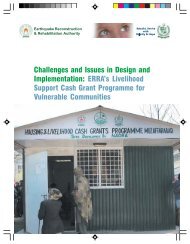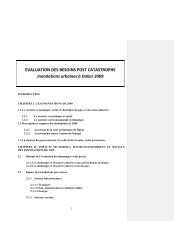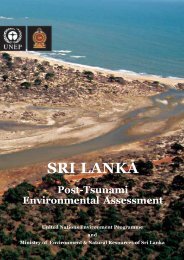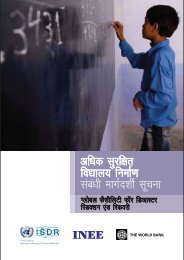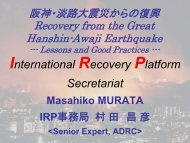Aceh Emergency Response and Transitional Recovery ... - UNDP
Aceh Emergency Response and Transitional Recovery ... - UNDP
Aceh Emergency Response and Transitional Recovery ... - UNDP
Create successful ePaper yourself
Turn your PDF publications into a flip-book with our unique Google optimized e-Paper software.
3. Shelter, Housing & Settlements<br />
“Now that I see that the construction of the house is almost complete, my<br />
thoughts are now busy with plans for the future. I want to look for funds to<br />
open again my car repair shop. I will be able to work <strong>and</strong> to provide work<br />
for three or four persons of the village, <strong>and</strong> my wife can start sewing<br />
again…,” says Pak. Mohtar Rudin a 37 year old beneficiary from Pulot<br />
Village in <strong>Aceh</strong> Besar.<br />
O<br />
verall, it is estimated that about 19% of the approximately 820,000 building<br />
units (about 151,600 units) in the affected districts suffered an average<br />
of about 50% damage while about 14% (about 127,300) were completely<br />
destroyed. People who have lost their homes are currently accommodated<br />
in numerous temporary settlement locations, in public buildings, or<br />
are living with host families. Early after the tsunami disaster, provision of emergency<br />
shelter was an urgent priority, <strong>and</strong> to this day the rehabilitation <strong>and</strong> reconstruction<br />
of housing is a chief priority in the reconstruction process.<br />
<strong>Emergency</strong> Shelter<br />
In the immediate aftermath of the tsunami disaster,<br />
<strong>UNDP</strong> distributed family tents as emergency shelter<br />
for those who lost their homes. While <strong>UNDP</strong><br />
does not normally work in the area of emergency<br />
shelter, the decision was taken to do so in <strong>Aceh</strong> based on the chronic nature of the<br />
need, following early damage assessments which indicated that a large percentage<br />
of the coastal population from Lhokseumawe to Meulaboh had been displaced,<br />
<strong>and</strong> therefore there would be a major need for emergency shelter.<br />
Through the ERTR Programme, 4,790 tents, including 3,750 provided by UK-<br />
DFID, were distributed across <strong>Aceh</strong> <strong>and</strong> Nias. The primary objective for <strong>UNDP</strong> in<br />
this project, as well as providing immediate relief <strong>and</strong> shelter to those who desperately<br />
needed it, was to develop direct relationships with displaced people who<br />
would in the future be in need of longer term recovery support of the kind that<br />
<strong>UNDP</strong> traditionally offers.<br />
The distribution of tents was as follows:<br />
Table 8 – Distribution of <strong>Emergency</strong> Shelter<br />
KEY RESULTS<br />
4,790 tents distributed to IDPs <strong>and</strong><br />
returning IDPs<br />
Location Agent Number of Tents<br />
B<strong>and</strong>a <strong>Aceh</strong> MPBI 1097<br />
B<strong>and</strong>a <strong>Aceh</strong> UPS/Uplink 400<br />
B<strong>and</strong>a <strong>Aceh</strong> UNHCR 1460<br />
B<strong>and</strong>a <strong>Aceh</strong> & <strong>Aceh</strong> Jaya JRS 150<br />
<strong>Aceh</strong> Barat BAKORNAS 200<br />
<strong>Aceh</strong> Barat UNHCR 50<br />
22


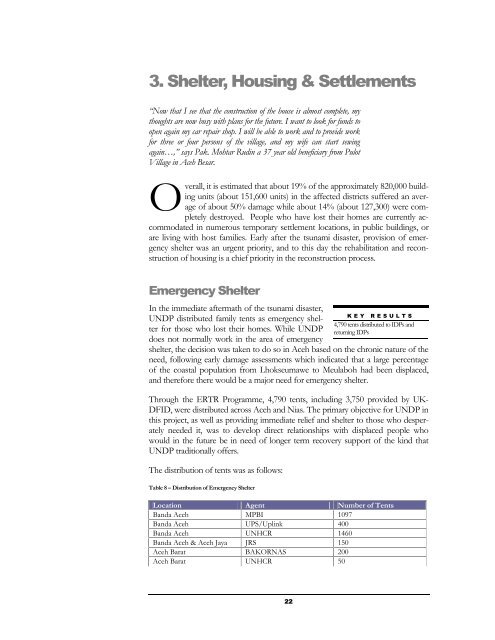


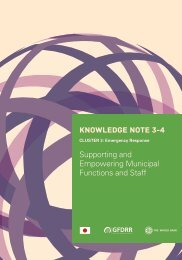
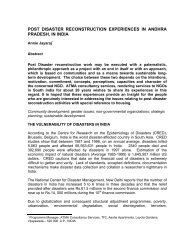
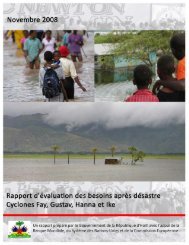
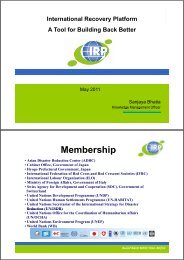
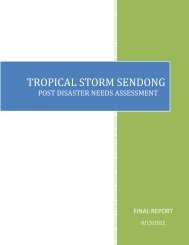
![View full document [PDF 7.65 MB] - unisdr](https://img.yumpu.com/48902806/1/178x260/view-full-document-pdf-765-mb-unisdr.jpg?quality=85)
